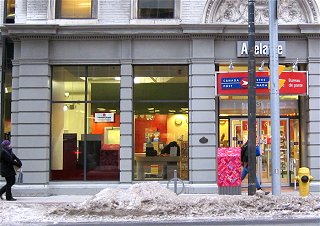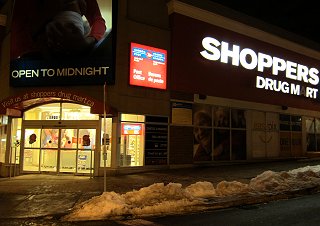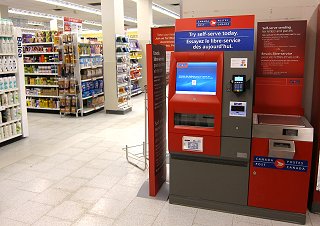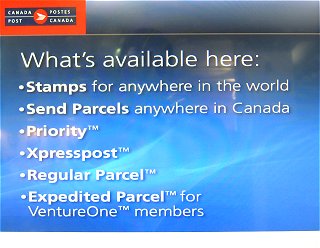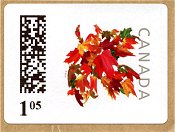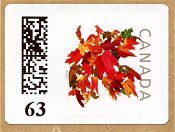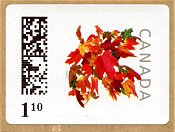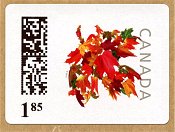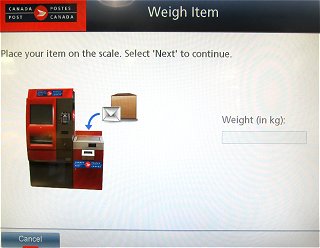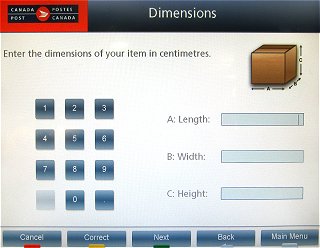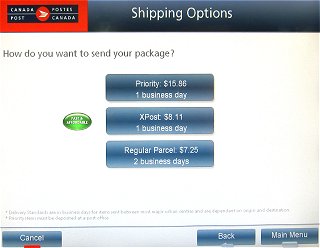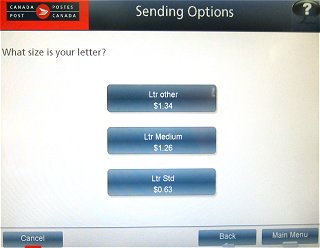| CANADA. The pilot trial using the Wincor Nixdorf postal kiosks |
| The pilot trial by CANADA POST |
| In early 2006, Canada Post began a project to install self-service postal kiosks where users could perform basic postal operations, such as purchasing stamps or franking letters and parcels. This first project was terminated in May 2007. |
 |
Four years later, in April 2011, the Canada Post Corporation returned to this idea and invited tenders to provide postal kiosks for a pilot trial, with the intention of investigating the feasibility of installing such equipment in its post office network, and to assess customer reaction.
The tender was finally awarded to Wincor Nixdorf Canada Inc, in August 2012.
The pilot is expected to last one year, and includes the installation of a total of 23 postal kiosks across the country. If the test proves successful, Canada Post could build a business case and consider the roll out of new equipment.
The first 8 self-service postal kiosks were installed from mid December 2012: four in Vancouver, three in Toronto and one in London, Ontario. The other machines were installed, from late January 2013, in Guelph, Longueil, Mississauga, Montreal, Richmond Hill, Scarborough, Toronto and Vancouver. Canada Post did not announce the start of the pilot until a month later, on January 15th 2013, through a note on the company's facebook page.
| Canada Post has about 6,500 branches across the country, a combination of corporate offices and franchises that are operated by private retailers in conjunction with a host retail business (right picture), such as pharmacies, convenience stores, or office supply stores, usually with extended opening hours. |
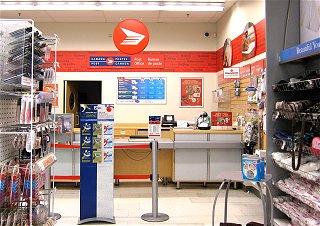 |
The new self-service postal kiosks are installed in post offices, such as the Adelaide post office, in Toronto ...
and also in stores, like this postal outlet in a SHOPPERS DRUG MART store in Toronto.
| The Wincor Nixdorf postal kiosks in Canada |
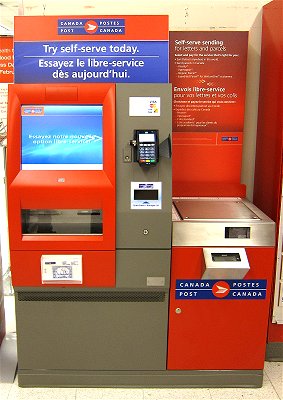 |
The postal kiosks installed belong to the ProPostal 2000 series, made by Wincor Nixdorf, and customized with the colours and logo of Canada Post.
It is the same type of kiosk that was installed, from 2011, in post offices in France (see article >>>, also published in VARIABLE 22), although the unit installed in Canada does not include the coin payment module, and the scale has been moved from the top to the side as a 'shelf' unit.
Because of some problems with usability, after a few weeks in service the first kiosks were replaced by new machines, which were modified to improve usability, using a new card payment module.
Communication with the user is through a large (17'') LCD touch screen. |
| Besides France, ProPostal 2000 postal kiosks by Wincor Nixdorf have also been in service in Ireland (see article >>>, and VARIABLE 10), and the United Kingdom (see article >>>, and VARIABLE 11) since 2008, although in both countries they are earlier units of a different design. |
After selecting the language (French or English), the user accesses the main menu (image below, right), with three options available, for the pilot:
- Buy stamps
- Ship a package or letter
- Track a package
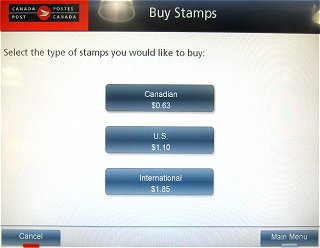 |
|
Selecting the 'Buy stamps' option, the user can purchase one or more variable value stamps or ATMs from any of the three current basic postal rates, corresponding to the three tariff zones established by Canada Post:
Letters up to 30 g. to Canada, United States and other countries (International).
On the start date of the pilot (December 12th 2012), these three values were 61 c. - $1.05 & $1.80 (pictures below).
From January 14th 2013, the three basic programmed rates increased to 63 c. - $1.10 & $1.85. |
Canada Post announced the installation of new kiosks on January 15th, one day after the postage rate increase, so very few collectors knew of the installations and used the few machines in service before that date.
During the early weeks of the pilot and, at least until the last revision of this article (March 2013), the second option ('Ship a package or letter') was only available for domestic shipments. On selecting this option, the system asks the user to place the postal item on the scale, and to indicate whether the item is a package or a letter, and the destination's postal code. If it's a package, then after inputting the dimensions, the system displays the different shipping options and postage rates available.
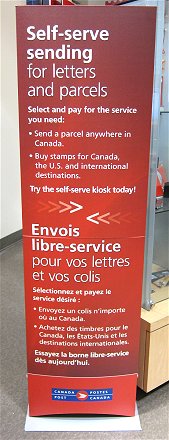 |
After selecting the shipment type and making payment, the kiosk issues a large postage label (102 x 153 mm.) with all the information about the shipment, printed by a direct thermal method on a self-adhesive white label. |
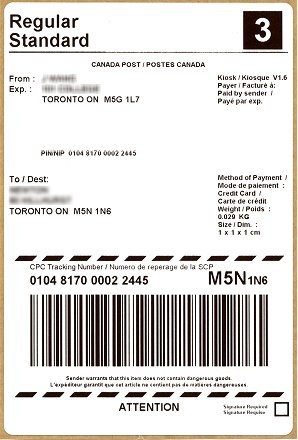 |
If it's a letter, the system shows the different postage rates, depending on the size. In this case, the kiosk again issues variable value stamps or ATMs with the corresponding face value.
In total, it is possible to obtain ATMs with 9 different face values - the 3 programmed in the 'Buy stamps' option, and the other 6, for domestic mail, that can be obtained by selecting the 'Ship a letter' option, and choosing a combination of weights and sizes.
- From the start date of the pilot until January 13th 2013, these values were 61 c., $1.05, $1.22, $1.29, $1.80, $2.10, $2.95, $3.40 & $3.65.
- From January 14th 2013, the 9 values are 63 c., $1.10, $1.26, $1.34, $1.85, $2.20, $3.05, $3.50 & $3.75. |
Purchase payment can be made only with a credit or debit card (picture, above right). Then the kiosk prints and cuts the stamps or ATMs one by one. The receipts are printed on rolls of thermal paper, 79 mm. wide.
From March 2013, the machines were modified to issue the ATMs in strips of up to 4 stamps.
|
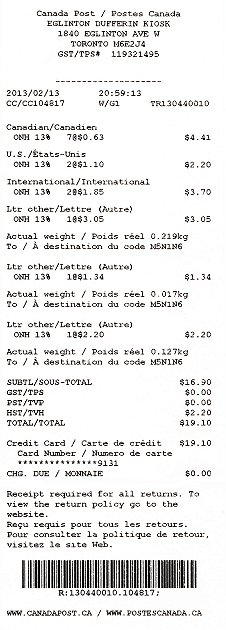 |
 |
 |
| 2012. The 'maple leaf' ATMs |
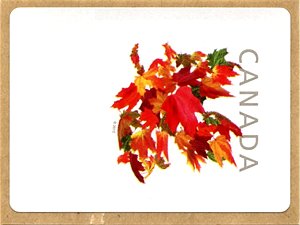 |
For the ATM issue, the Wincor Nixdorf postal kiosks uses rolls of 5,000 self-adhesive labels on a brown backing paper, manufactured by Data Group company. The size of the stamps is 41 x 30 mm. |
The labels include a preprinted design with the name of the country and a maple leaves composition forming a single leaf. It is a design by Denis Page & Oliver Hill.
The issue also includes the micro printed date, integrated into the design. |
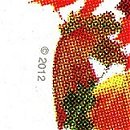 |
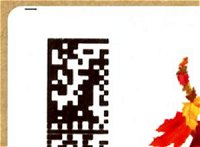 |
Small black lines, guidelines or cutting marks, can be seen on some ATMs, near the upper corners. These lines were printed during the manufacture of the labels, and appear sequentially in the rolls. |
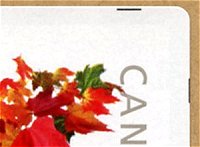 |
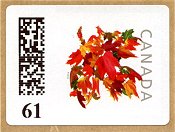 |
Wincor Nixdorf postal kiosks print, by a direct thermal method, a two-dimensional code and the face value on the labels. |
| The 2D code provides information about the issue of the stamp and its face value, which can be automatically read by Canada Post mail processing equipment. |
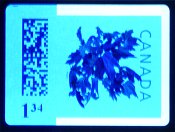 |
| Labels also include fluorescent tagging on 3 sides, as seen in the image taken under a UV light. |
| Canada Post released a first day cover illustrated with the image of the new postal kiosks. The envelope is franked with a 61 c. face value ATM, the basic domestic postage rate on the date of issue. The special postmark shows the location - TORONTO ON. |
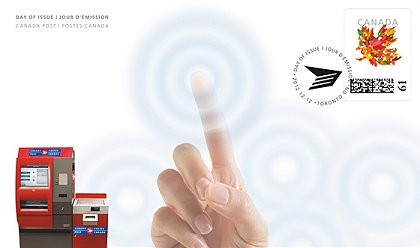 |
With the collaboration of Jean Wang.
ATM Web - Spain and Latin American Postal Services: http://www.ateeme.net
© J. Jove - M. Sans. ATEEME. Variable value stamps study group. All rights reserved
This page was created in February 2013 and last updated:
11.04.13
. English edition rewritten by S. Goodman (18.03.2013)
|


